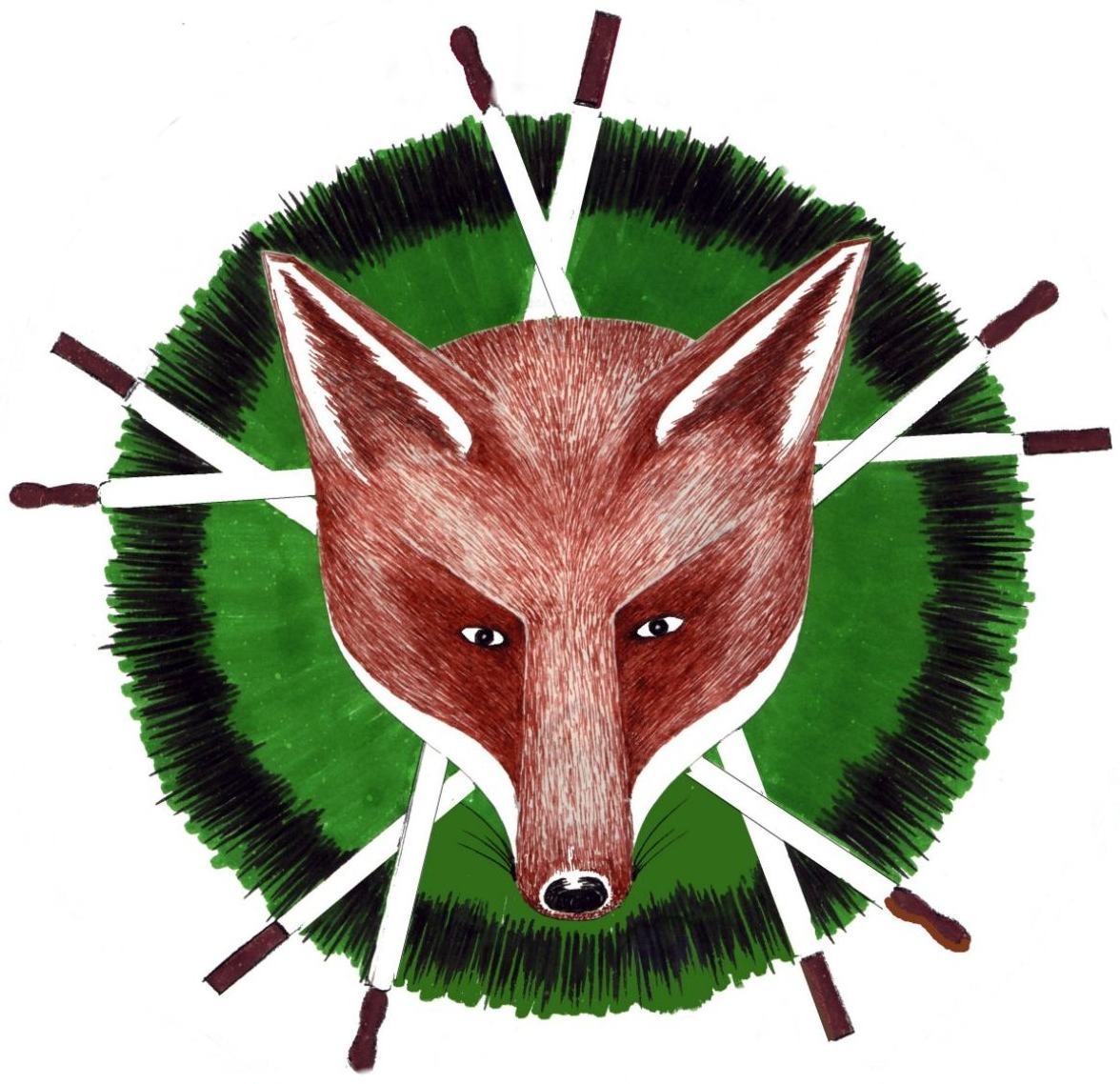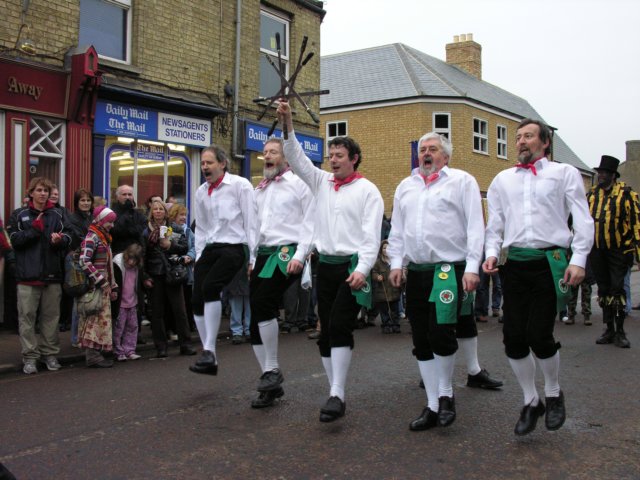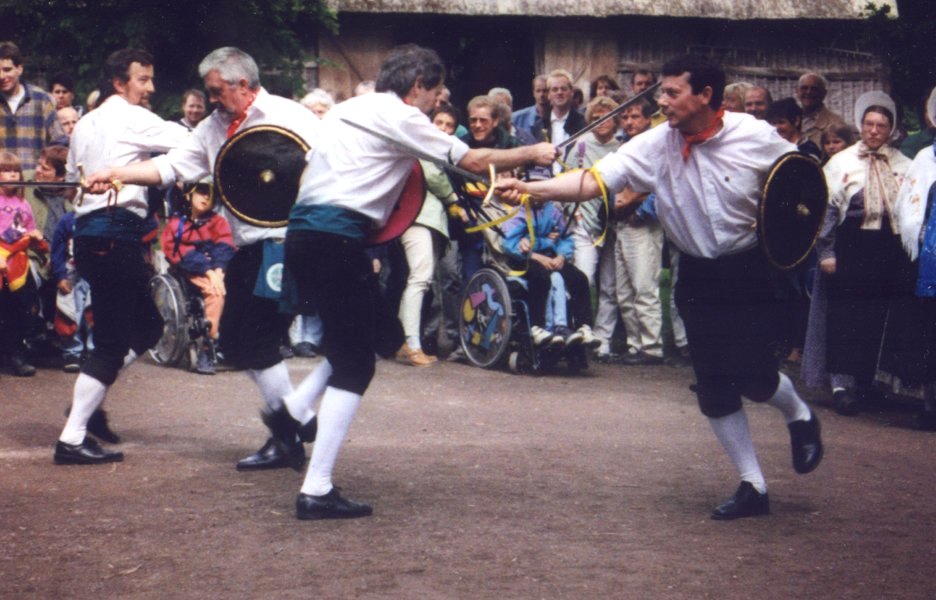
Stevenage Sword Dancers perform traditional sword dances from the North-East of England - Rapper and Longsword.
We are based in Stevenage in Hertfordshire, England. Our favourite activity is to visit a few pubs to entertain the drinkers with the Rapper dance and collect for our beer. We dance in the summer with local Morris sides and occasionally at sword dance meetings or folk festivals.
We practise most Tuesday evenings from about 8.30 in Stevenage. Contact the side to check exactly where and when. Recruits with or without experience are welcome (as the oldest member of the regular side would like to retire but we can't spare him yet.)
As we mainly dance for the customers in the pubs we visit and tours are only set up a couple of weeks ahead, anyone wanting to see us in action should contact the side for details.
 Rapper is a fast, exciting dance, best seen at close quarters in a pub. A rapper 'sword' is a short, whippy, double-handled blade,
which allows a complex dance in a small space. The blade is not sharp but can draw blood when scraped across a knuckle or nose.
Rapper dances come from the mining areas around Newcastle and Durham, where each village might have its own team.
Our dances are evolved from the traditions of Newbiggin, Swalwell and Beadnell.
After years away from their homeland some of the dances have evolved, we hope in keeping with the tradition behind them.
The dances are traditionally always for five dancers.
Rapper is a fast, exciting dance, best seen at close quarters in a pub. A rapper 'sword' is a short, whippy, double-handled blade,
which allows a complex dance in a small space. The blade is not sharp but can draw blood when scraped across a knuckle or nose.
Rapper dances come from the mining areas around Newcastle and Durham, where each village might have its own team.
Our dances are evolved from the traditions of Newbiggin, Swalwell and Beadnell.
After years away from their homeland some of the dances have evolved, we hope in keeping with the tradition behind them.
The dances are traditionally always for five dancers.
.jpg) Longsword dances have been recorded all over Europe since about 1400. The English dances mainly come from Yorkshire.
They use a long, rigid, one-handled blade and there are normally about 6-8 dancers.
As it takes up more space than the Rapper, it is usually performed out of doors.
Longsword dances have been recorded all over Europe since about 1400. The English dances mainly come from Yorkshire.
They use a long, rigid, one-handled blade and there are normally about 6-8 dancers.
As it takes up more space than the Rapper, it is usually performed out of doors.
 As well as the English dances, we occasionally perform the Buffens, a French dance, recorded in 1589.
The traditional English dances are 'linked' - both ends of the swords are in the dancers hands; the Buffens, is a 'fighting dance'in which the dancers hold one end and clash the swords.
As well as the English dances, we occasionally perform the Buffens, a French dance, recorded in 1589.
The traditional English dances are 'linked' - both ends of the swords are in the dancers hands; the Buffens, is a 'fighting dance'in which the dancers hold one end and clash the swords.
The music for Rapper is a fast jig tune (6/8 time, at 130-160 beats/min) such as Cock
o' the North or Tenpenny Bit. Typical instruments are Fiddle, Concertina, Accordion,
Whistle, Mouth organ and Melodeon. As well as these, we have danced to the Bagpipes
(Highland , Border & Northumberland), Banjo, Guitar, Tuba and Suzaphone as well as the
occasional ceilidh band. A typical tune and speed is this clip, by our first musician, Bob Day (400k) . Our one-time piper, Ian Lawther, can be heard at his
own web site.
The Longsword music is slower, in 4/4 time, such as The Oyster Girl or The Keel Row .
Back in 1973, one Brian Kell from Co Durham found himself working in Stevenage. After dancing with Sallyport Sword he naturally missed the masochism of gashed knuckles so trawled the local folk-song clubs to recruit an unwitting bunch of southerners to share the pain. The embryonic SS made their debut at the '73 Cambridge Folk Festival. 1974 saw their first regular 'dancing out' in pub tours around Stevenage, visiting five, six or even seven pubs in an evening. In the next year the side expanded from the original 5 to about ten members. The team was given much encouragement by Morris Sunderland, then Squire of the Morris Ring and fool of Offley Morrismen. He introduced us into the Ring in 1975. Some highlights in the team's history have been:
1973 Cambridge Folk Festival
1975 Ipswich ring meeting- where a loose sword caused 300 watching morrismen to hold their breath until it was recovered. (All part of the show, honest!)
1977 Selm,Germany. Where Mark Harris discovered what our sashes are for - to tie to the nearest bar when beer and gravity conspire against you.
1979 Isle of Wight ring meeting- open-top buses, low flying trees and bare-ass morris on the ferry slipway at Cowes
1980 January - First Whittlesea Straw Bear - and we've been to every one since.
1981 Towersey Festival - mystical, firelight longsword and Great Western Morris with rapper on stilts.
1991 Osnabrück, Germany, filling up a coach for Derby Morris, to visit Osnabrücker Trachtenkreis dance team, with a scratch side collected from around the country - puzzled looks at motorway stops across 5 countries as we took every opportunity for a practise.
1991 Rose of Tralee festival, Ireland with Redbornstoke Morris, Iron Men &
Severn Guilders; all Guinness & no sleep!
1995 Osnabrück with Derby Morris again for Osnabrücker Trachtenkreis' 40th anniversary
1996 Scarborough International Sword Dance Festival, A fantastic gathering with about 15 overseas sides and 30 UK sides, but not enough time to see them all!
1997 Canal Tour with Jack the Rapper from Norway, Grand Union Canal, Aquavit and Stockfish. Pity about the dancing!
1998 March - DERT at Gateshead Winners of the blindfold Rapper class.
1998 Whitby International Sword Spectacular ,
1998 Killala, Mayo, Celebration of the doomed 1798 French invasion in support of the uprising against the English. (why??!)
1998 September - 25 years old!
1999 March - DERT at Newcastle - no team, so judging.
1999 May - Osnabrück with Derby and Chapel en le Frith MM
2000 March - DERT in the Millenium Dome missed it!.
2000 May - Covent Garden & Old Bank of England for Norwegian Conference
2000 May - Whitby Millenium Sword Spectacular
2000 September - Quidditch match with White Rose, Huddersfield
2001 March - DERT in Masham Balck Sheep Brewery three of us (only for the beer)
2001 May - Hosts to Osnabrücker Trachtenkreis visiting Stevenage,London & Derby MM
2001 December - Oxford with Mabel Gubbins - Four men and a Thrale (thanks Andy!).
2002 February - Italy - Rocca Grimalda Carnival.
2002 December - Oxford with Mabel Gubbins - The Bloodbath tour aka "When Mr Bump's sword met Julie's nose" (*Mr Bump).
2002 July - Berlin - sword dance seminar for Potsdam-based dance group.
2003 March - DERT in Glasgow - in the pubs for a change.
2003 May - Osnabrück
2003 September - 30 years old! - and still going.
2003 December - Oxford again with Mabel Gubbins - Debut of the S-Sword Oxford branch and winners of the Blood Sports prize.
2004 May - 4th International Sword Spectacular at Whitby. Forging transatlantic links with the great Great Meadows teams from Boston.
2006 April - DERT, York. Not the winners but we did well.
2008 June - To Eliant, Brittany for a weekend as guests of Eilan Paddy. English beer, french style (strong!), lots of laughs and Bombards!
2009 January - 30th Whittlesea Straw Bear! - and we've been to every one.
1.A rapper 'sword' is a flexible, springy metal blade about two feet (60cm) long by one inch (25mm)
wide with a fixed wooden handle at one end and a swivelling or fixed handle at the other.
Use of spring steel dates the earliest rappers to the early 1800s.
2. Rapper is a fast dance performed by five masochists, linked hand-to-hand by rapper swords. The dancers weave the swords in a variety of convolutions while scraping skin off their knuckles and beer-glasses off nearby tables. Between movements a simple 1-2-3 1-2-3 clog-step is danced, often in time to the music. In some figures the rapper Lock or Nut is displayed, which figures in our badge.
The dancers are normally accompanied by two 'characters' who get in the way and distract the audience from the dancers' mistakes
- a tail-coated Tommy and transvestite, busty, and preferably bearded Betty.
For more information about rapper dances and teams, see Rapper Online
The Newbiggin dance was described by Marjorie Sinclair & Elsie Whiteman in the EFDSS publication 'The North Skelton Sword-Dance and the Newbiggin Rapper Sword-Dance'. The figures were taught by Mr William Clark of Newbiggin at an EFDS meeting in Buxton in 1927. The figures, with additions and variations, are descended from the North Walbottle dance described by Cecil Sharp.
The Swalwell dance is described by Cecil Sharp in 'The Sword dances of Northern England' in 1911.
<The longsword used in the English traditions is a rigid steel blade with one wooden handle, or a wooden blade, about three/four feet (100-120cm) long and 1-2 inches (25-50 cm) wide. Though called a sword, the edges are not sharpened unless the team is in a bad mood. The dances are normally at brisk walking pace or gentle run and performed by six to eight dancers who weave between each other in a number of set figures to make up a complete dance.
The longsword is an older dance, pre-dating the Morris, with roots and relatives all over Europe , where the earliest records date to at least 1400. Its traditional roots in England are mainly in Yorkshire. It is often danced in a 'military' style with precise, emphasized footwork with the team dressed in military-style uniforms. A few sides, including Stevenage, dance it in a smoother, ritual style.
The many English longsword dances are well documented in
'Longsword Dances from Traditional and Manuscript Sources' by Ivor Allsop
'Longsword: An Introduction to the Longsword Dance Tradition of Yorkshire' by Diana Jewitt.
The history of sword dances through Europe is well documented in
'Sword Dancing in Europe: A History' by Stephen D Corrsin
Two examples of European longsword dances can be seen at Boerke Nass (Belgium) and Korcula (Croatia).
The Buffens was described by Thoinot Arbeau, a French dancing master, in his 1589 book 'Orchesography'. We were prompted to dance it by discovering a set of swords (and shields) for sale, which had been used in the 1950s by a Hertfordshire group, the 'Elizabethans'.
The Fox in our badge is taken from the pub we used to retire to after practices, 'The Twin Foxes', itself named after a notorious pair of local poachers, the identical twins, Albert and Ebenezer Fox.
is 30 miles (50Km) north of London. Stevenage has a history going back to at least Roman times and boasts 6 Roman tumuli close to the ancient 'Great North Road' which ran through the town. Stevenage was an important coaching stop on the GNR in the days of horse-drawn coaches. Stevenage New Town was developed in the 1950s as one of the post WW2 London overspill towns.
Brian came to Stevenage after dancing with Sallyport Sword. Having got the side started, Brian moved with his job to Whittlesey in Cambridgeshire where he was instrumental in reviving the Straw Bear custom in 1980 and the excellent Longsword team, Wype Doles.